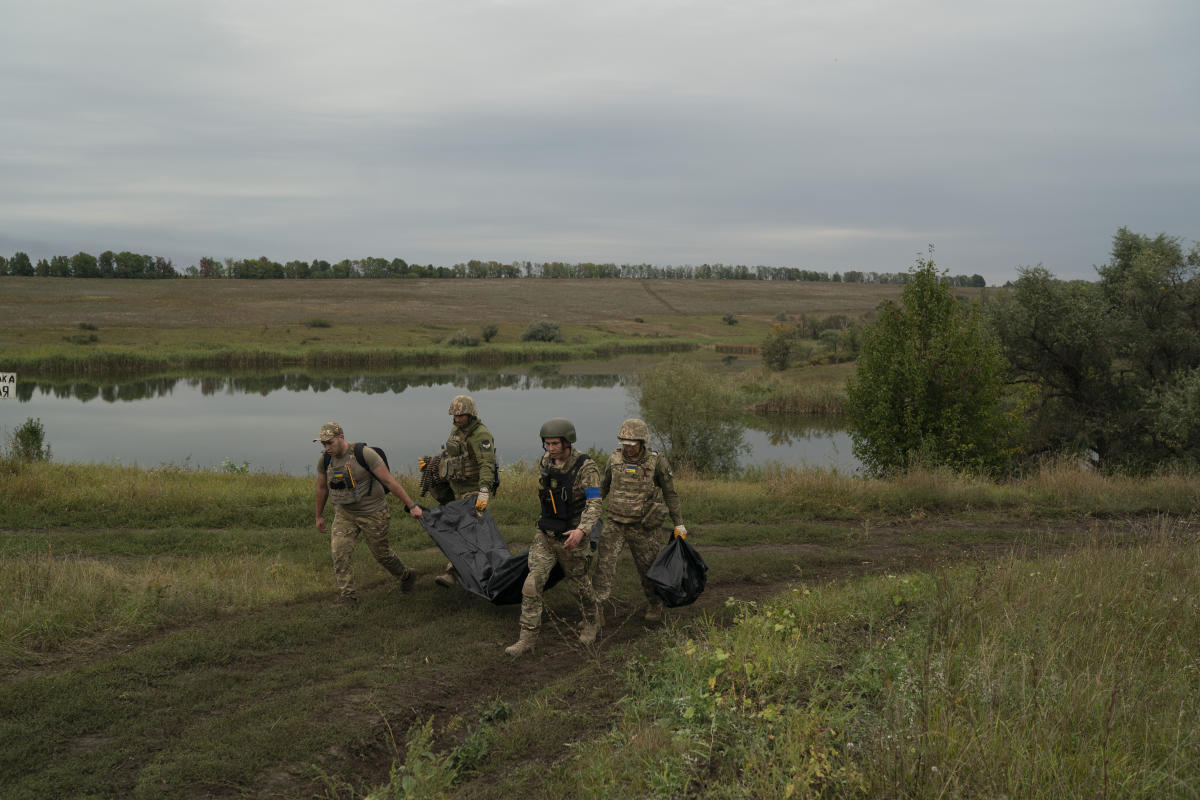KOZACHA LOPAN, Ukraine (AP) — There are still bodies on the battlefield, lying where they fell on fields or in burned-out tanks as Ukrainian forces marched across Russian-occupied territory in a major counter-offensive this month.
In this northeast corner of Ukraine, after holding the area for months, the Russian army was pushed all the way back over the border into Russia. But artillery shells are still whistling through the air, fired from Russia and lands with resonating booms and black clouds of smoke on Ukrainian soil.
Despite the shelling, a small group of soldiers make their way along a muddy trail to the site of a dead Ukrainian fighter, spotted by a drone used to search for bodies and shallow graves.
“It is a risk. We are always risking our lives and at any moment a grenade could fly in from the territory of Russia,” said Vitalii, a commander of the National Guard whose men are looking for bodies of soldiers from both sides and he asked only for security reasons to be identified by his first name.
The dead Ukrainian lies on his back in body armor and helmet, with a cap underneath to block the sun. The body has been there for a long time.
They document the scene and lift the remains into a body bag before continuing down the track to a charred Russian tank. It only takes one of the team to carry away the body bag containing the Russian’s remains.
Autopsies will follow and details of the locations will be recorded and passed on to investigators investigating possible war crimes, Vitalii said.
The nearby village of Kozacha Lopan, the edge of which is less than two kilometers (just over a mile) from the Russian border, was recaptured by Ukrainian forces on September 11.
Vitalii said the team is also searching for graves of possible victims of what authorities say was a makeshift prison where inmates were abused.
In the damp basement behind the local supermarket, metal bars fence off a corner of the room to form a large cell. Dirty sleeping bags and duvets show three sleeping places on top of polystyrene sheets for insulation from the damp bare earth floor. In the corner two black buckets served as a toilet.
A few feet outside the barred cell are three dilapidated chairs around a table, cigarette butts and empty pumpkin seed husks around them on the floor.
In a statement posted on its Telegram channel on Saturday, the prosecutor’s office of the Kharkiv region, in whose jurisdiction Kozacha Lopan is located, said the room was used as a torture cell during the occupation of the area by Russian troops.
The prosecutor’s office said Russian troops had set up a local police force to manage the prison, adding that documents confirming the functioning of the police and torture devices had been seized. The statement states that an investigation is underway.
The claims of what happened in the room could not be independently confirmed.
Cemeteries have been found in some areas where Russian troops were driven out, most notably in the city of Izium, where Ukrainian officials say more than 440 graves have been found near the city’s cemetery. President Volodymyr Zelenskyy has said they contain the bodies of adult civilians and children, as well as soldiers, who show signs of violent deaths, some possibly from torture.
In this border region, where fierce fighting raged, villages bear the devastating scars of war: houses bombed and burned, roads cratered from exploding mortar shells, cars crashed by the roadside.
In the days after the Russians were driven out, local people have returned to see what is left of their homes.
“Three days before we decided to leave, it was hell here” after all the shootings, said Larysa Letiucha, 56, in the nearby village of Prudyanka. “It flew from everywhere. It whistles and explodes. We hid in the basement and … our door was blown off.’
She left with her family in April and returned to check her property a few days after Ukrainian soldiers recaptured the village.
“I saw a horror. I still can’t get myself together,” she said as she recounted her first sight of what was left of her house. “We have lived here all our lives. We were building it, remodeling it. Our whole lives have been invested here.”
The windows have been blasted in and the ceiling is leaking from where a patch is missing due to an explosion. In the house that her parents built on the same plot, the entire rear part is missing. Shrapnel and debris litter the house.
“Our houses are comfortable, even though we live in the village,” Letiucha said. “It is an abomination. I don’t even know when we’re going to renovate and rebuild all this.”

